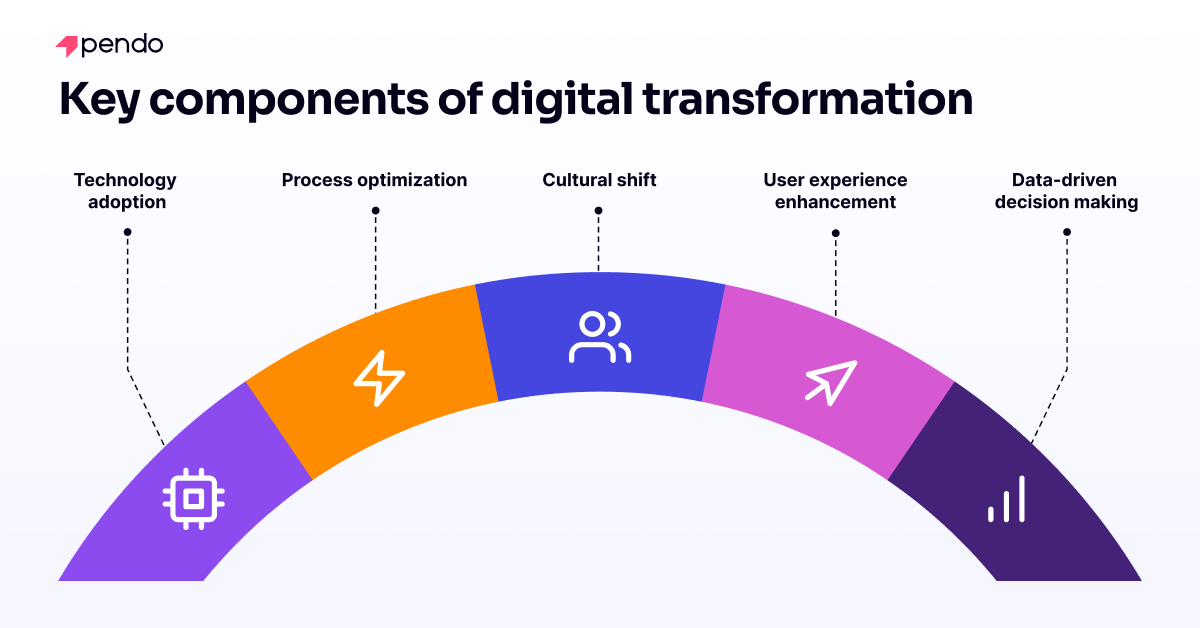
包括的ガイド
DX
ビジネスや組織のあらゆる側面にデジタルテクノロジーを統合し、その運営方法や顧客への価値提供方法を根本的に変えるプロセス。
さらに深く掘り下げる
目次
デジタルトランスフォーメーション(DX)とは
デジタルトランスフォーメーションとは、ビジネスや組織のあらゆる側面にデジタルテクノロジーを統合し、その運営方法や顧客への価値提供方法を根本的に変えるプロセスを指します。これには、デジタルツールとテクノロジーを活用してプロセスを合理化し、顧客体験を向上させ、さまざまな機能や部門間でイノベーションを推進することが含まれます。
Because digital transformation can be applied to a broad spectrum of changes, businesses can tailor their approach based on their specific needs and goals. This flexibility can, however, lead to varying interpretations of what “digital transformation” truly means. For some organizations, digital transformation may involve no more than adopting a few digital tools to replace selected manual processes. Others pursue a complete overhaul, embracing the latest emerging technologies and fundamentally changing their business model. While most organizations’ digital transformation initiatives lie in between, they all share one thing in common: digital adoption is crucial to their success.
デジタルトランスフォーメーションが重要な理由
Digital transformation is essential for an organization to stay competitive in today’s rapidly evolving business landscape. It allows companies to adapt to changing market demands, improve operational efficiency, and capitalize on opportunities presented by new technological advances. Here are some ways embracing digital transformation helps ensure the modern business organization stays ahead.
Adapting to evolving customer needs: Today’s customers are tech-savvy and expect seamless digital experiences. Digital transformation allows businesses to leverage technology to:
- Personalize customer interactions: By gathering and analyzing customer data, businesses can personalize product recommendations, offers, and marketing campaigns, leading to higher customer satisfaction and loyalty.
- Offer omnichannel customer support: Customers expect to interact with businesses through channels like mobile apps, social media, or live chat. Digital transformation facilitates the creation of omnichannel support structures, ensuring consistent and convenient customer service across all touchpoints.
- Embrace new business models: Digital transformation unlocks the potential for innovative business models like subscription services, direct-to-consumer channels, or the sharing economy. These models cater to changing customer preferences and can create new revenue streams.
Enhanced operational efficiency and productivity: Digital transformation can significantly improve internal operations beyond the customer-facing aspects. It can facilitate:
- Automating repetitive tasks like data entry, report generation, and customer service inquiries, freeing up employee time for more strategic and value-added activities.
- Streamlined workflows using digital tools to re-engineer or reimagine existing manual workflows, eliminating redundancies, improving collaboration, and reducing operational costs.
- Data-driven decision making by leveraging data analytics to gain insights into current operational performance and identify areas for improvement. Fostering a data-driven approach allows the business to make informed decisions to optimize processes and resource allocation.
Innovation and agility to capitalize on new opportunities: With the speed of marketplace change today, the ability to innovate and adapt quickly is crucial. Digital transformation fosters a culture of:
- Experimentation: Digital tools and platforms enable businesses and individuals to experiment with new ideas, test prototypes quickly, and iterate based on user feedback, speeding development of new products and services that meet new market demands.
- Increased collaboration: Digital collaboration tools can break down silos and facilitate teamwork across departments, fostering knowledge sharing, accelerating problem-solving, and promoting innovation.
- Scalability and flexibility: Digital infrastructure allows businesses to scale operations up or down more efficiently to meet fluctuating market demands. This agility enables them to seize new opportunities and respond to market disruptions more effectively.
By embracing digital transformation, businesses can future-proof themselves and maintain relevance in an increasingly digital world. However, simply deploying new technology isn’t enough. To fully realize its benefits requires high digital adoption of said technology by the organization’s employees, customers, or both.
デジタルトランスフォーメーション(DX)における重要な構成要素とは
デジタルトランスフォーメーション(DX)は、相互に関連するさまざまな構成要素を包含する総合的な取り組みです。
1. Technology adoption: Implementing and adopting new digital tools and platforms such as cloud computing, artificial intelligence (AI), Internet of Things (IoT), and data analytics to drive efficiency and innovation.
- Cloud computing offers scalability, flexibility, and faster deployment of new technologies.
- AI can automate tasks, personalize experiences, and generate insights from data (chatbots, machine learning, NLP).
- Big data analytics extracts valuable insights from vast data sets for better decision-making.
- IoT connects devices to collect real-time data (operations, products, customers) for predictive maintenance, resource optimization, and data-driven product development.
- Cybersecurity tools protect sensitive data and ensure business continuity as digital technologies integrate.
2. Process optimization: Re-engineering business processes to leverage digital technologies for improved efficiency, productivity, and agility.
- Process mapping and analysis can identify and analyze existing business processes to reveal inefficiencies and opportunities for automation.
- Workflow automation leverages digital tools to automate repetitive tasks, freeing employee time for more strategic activities and improving overall process efficiency.
- Data-driven process improvement uses data analytics to reveal bottlenecks and areas for improvement within existing processes. Businesses can then utilize these insights to streamline workflows in a continuous improvement cycle.
3. Cultural shift: Fostering a culture of innovation, collaboration, and continuous learning to support digital initiatives and drive organizational change.
- Leadership commitment: Demonstrating strong leadership buy-in, clear vision communication, and resource allocation is crucial.
- Change management: Developing a strategy for clear communication, employee training, and addressing resistance helps ensure a smooth transition.
- Employee empowerment: Equipping employees to thrive in the digital age may involve training and support on new technologies and encouraging continuous learning and experimentation.
- Collaboration and transparency: Promote open communication, cross-department collaboration, and knowledge sharing to break down silos and drive innovation.
4. User experience (UX) enhancement: Using digital channels and technologies to enhance customer interactions, personalize experiences, and deliver added value.
- Personalizing the customer journey includes leveraging data and analytics to tailor marketing campaigns, product recommendations, and support interactions for individual users’ needs and preferences.
- Leveraging digital touchpoints uses mobile applications, self-service portals, and social media to provide convenient and personalized user experiences.
- Omnichannel customer support offers consistent and seamless user support across all touchpoints, including phone, email, live chat, and social media.
- Investing in user experience (UX) design results in user-friendly digital experiences across websites, mobile apps, and other digital touchpoints to improve user satisfaction and engagement.
5. Data-driven decision making: Harnessing data analytics and insights to make informed decisions, optimize strategies, and drive business outcomes.
- Data collection and integration require strategies to collect, store, and integrate data from various sources, including user interactions, operational systems, and marketing campaigns.
- Data analysis and visualization use digital tools to generate reports that translate complex data sets into actionable insights.
- Using data to inform strategy means leveraging data insights to inform strategic decision-making across all levels of the organization, from product development to resource allocation, operational optimization, and more.
デジタルトランスフォーメーションのメリットとは
デジタルトランスフォーメーション(DX)は組織に多くのメリットをもたらします。そのうちの一部は、DXの重要性と主な構成要素に関する本ガイドの各セクションで示唆されています。 ここではその他多くのメリットをご紹介しつつ、DXがその実現にどのように役立つかを概説します。
- Improved operational efficiency: Streamlining processes and automating tasks increase efficiency and reduce operational costs.
- Enhanced customer experience: Leveraging digital channels and personalized interactions can boost customer satisfaction and loyalty.
- Innovation and agility: Embracing digital technologies fosters innovation and enables organizations to adapt quickly to changing market dynamics.
- Competitive advantage: Digital transformation can differentiate businesses from competitors and open up new revenue streams.
- Data insights: Access to data analytics allows organizations to gain valuable insights into customer behavior, market trends, and operational performance, enabling data-driven decision-making.
- Improved employee productivity and satisfaction: Automating repetitive tasks and streamlining workflows frees up employee time, allowing them to focus on higher-value activities that contribute more to the organization’s success.
- Enhanced risk management: Data analytics can help identify potential risks early on, enabling businesses to take proactive measures to mitigate them.
- Improved brand reputation: By delivering exceptional customer experiences and embracing innovation, businesses can enhance their brand image and build stronger customer relationships.
- Increased talent acquisition and retention: Focusing on digital transformation can make an organization more attractive to prospective employees seeking opportunities to work with cutting-edge technologies and in a culture of innovation.
デジタル変革への抵抗を克服する方法
多くの場合、デジタル変革に対するユーザーの抵抗は不安や不確実性に起因します。このような抵抗を克服するためには、最初からすべての関係者を変革プロセスに参画させること、オープンなコミュニケーションを育むこと、十分なトレーニングを提供することが効果的です。
デジタルツールに関わる懸念事項に対処し、その利点を促進することに特化した変更管理チームを設けるのもよいでしょう。効率性の向上や専門家としての成長の機会である点など、DXがもたらす対個人および対組織のメリットを強調することで、抵抗を減らすこともできます。さらに、組織内のアンバサダーや変革の推進者を活用することで、ポジティブな成果が発信され、変化の受容を促進することができます。
デジタルトランスフォーメーションに伴うリスクと課題
デジタルトランスフォーメーション(DX)は大きなメリットをもたらしますが、考慮すべき課題もあります。幸いなことに、課題に対処し、克服するためのDX戦略が存在します。
- Legacy systems integration: Integrating new digital technologies with legacy systems can be complex and costly. A phased approach to modernization should be developed, focusing on critical systems first and exploring cloud-based alternatives for legacy systems that are difficult to integrate.
- Change management: Overcoming resistance to change and ensuring buy-in from employees across the organization is critical for successful digital transformation. Implement a comprehensive change management strategy that includes effective communication plans, transparent leadership, and employee training programs to equip them with the skills and knowledge to succeed in the new digital landscape.
- Data security and privacy: Protecting sensitive data and ensuring compliance with regulations like GDPR and CCPA (California Consumer Privacy Act) requires robust security measures. To comply with these needs, invest in cybersecurity tools and expertise to protect data, implement data governance policies, and regularly assess and update security measures.
- Skills gap: Acquiring the necessary digital skills and talent can be challenging in an evolving technology landscape, not to mention relatively ineffective and costly. Traditional methods to bridge the gap include investing in employee training programs, developing upskilling and reskilling initiatives, and considering partnerships with educational institutions or technology firms to bridge the skills gap. A digital adoption solution can provide faster, more efficient, and cost-effective onboarding than traditional forms, as well as ongoing user support and learning via in-app guides.
DXが顧客体験に与える影響とは
DXは、テクノロジーを統合してサービスの提供を合理化し、インタラクションをパーソナライズすることで顧客体験を根本的に向上させます。これには、顧客データを収集して活用し、カスタマイズされたサービスを提供する顧客関係管理(CRM)システムの導入や、24時間週7日体制で即座に応答するチャットボットによるAI顧客サポートの強化などが含まれます。さらに、複数サービスをアクセスしやすい単一プラットフォームに統合するモバイルアプリケーションを開発することで、カスタマージャーニーは大幅に改善され、満足度とロイヤルティの向上につながります。
組織がデジタルトランスフォーメーションを上手く導入する方法
デジタルトランスフォーメーション(DX)を成功裏に導入するには、組織は次の項目について戦略を策定し、実行する必要があります。
1. Define clear objectives and strategy: Establish clear goals and a well-defined approach for digital transformation, aligning it with the overall business objectives. This strategy should identify and document critical focus areas, prioritize initiatives, and define success metrics.
2. Secure leadership support: Gain strong buy-in and support from senior leadership. Leaders must loudly and visibly champion the change, communicate the vision clearly, and allocate the necessary resources.
3. Focus on user needs: Digital transformation initiatives inevitably affect how your employees perform their tasks or how customers interact with your brand (or both). This strategy should:
- Conduct deep user research. You need to gain a deep understanding of users’ needs, expectations, and pain points through surveys, focus groups, and customer journey mapping. This research will help prioritize digital transformation initiatives that deliver the most value to your users.
- Align digital initiatives with user experience. Ensure that all digital transformation efforts are designed to improve the user experience. This could involve streamlining the user journey, personalizing interactions, or offering new digital touchpoints for greater convenience and engagement.
- Measure user satisfaction. Continuously track employee/customer satisfaction metrics such as Net Promoter Score (NPS) and Customer Satisfaction Score (CSAT) to assess the impact of digital transformation initiatives on user experience.
4. Empower users to boost digital adoption: Invest in training and development to equip employees and customers with the necessary digital skills and empower them to drive change. Some components of this strategy include developing
- Skills gap analysis: Identify current user skill sets and the additional skills needed to thrive in the digital age.
- Develop training programs: Invest in training programs and digital adoption solutions that provide in-app guides and real-time support for the new applications or features. These should equip users with the skills and knowledge to effectively utilize the new technologies and processes.
- Change management communication: Communicate the purpose and benefits of digital transformation clearly to users, addressing any concerns and fostering a sense of ownership for the change.
- Ongoing support: Provide user support throughout the transformation process, including the in-app guides and direct, dedicated support mentioned earlier.
5. Take an iterative approach: Start with small-scale pilot projects to test new technologies and processes before deploying them organization-wide. This allows for course correction and refinement before a full-scale rollout. Then, embrace an agile approach with short development cycles, iterative testing, and continuous improvement based on feedback and results.
6. Continuously monitor and measure progress: Always leverage data analytics to track progress, measure an initiative’s impact, and identify improvement areas.
- Define key performance indicators (KPIs): These KPIs can measure aspects such as customer satisfaction, employee productivity, operational efficiency, or return on investment (ROI) of digital initiatives.
- Regularly report progress: Report progress against established KPIs to assess the effectiveness of digital transformation efforts and identify areas for improvement.
- Communicate results —Always! Communicate the results of digital transformation initiatives to stakeholders and employees to demonstrate the value and impact of the transformation journey.
これらの包括的な戦略に従うことで、組織は課題を克服し、DXの大きな可能性を引き出すことができます。
DXの推進要因は業界によって異なりますか?
はい。DXの推進要因は業界によって大きく異なり、各業界が抱える固有の課題と機会によって形作られています。以下はその例です。
- ヘルスケア業界におけるDXは、効率的でエラーのない患者へのケアとデータ管理の必要性によって推進されています。
- 小売企業におけるDXは、eコマースを進化させ、顧客データ分析を活用してパーソナライズされた購買体験を実現する必要性によって推進されています。
- 製造業界では、予知保全やその他の「スマート製造」機能の構築がDXの主要な推進力となっています。
- 金融業界では、サイバーセキュリティの進歩と、顧客との信頼関係や規制遵守を強化するデジタルバンキングソリューションが、DX推進の重要な役割を果たしています。
各組織がDXの推進要因を理解することで、DXの取り組みと業界固有の目標を戦略的に連動させ、取り組みの関連性と有効性を確保できます。
デジタルトランスフォーメーションの成功例とは
チャンスは無限大です。 ほぼすべての業界の組織がDXの取り組みを成功させ、本ガイドに記載されているメリットを享受しています。ここではDXのインパクトを示す実例として、著名な企業をいくつかご紹介します。
- Retail: Walmart has doubled down on digital transformation by investing in e-commerce, omnichannel fulfillment options (buy online, pick up in store), and leveraging big data analytics to personalize customer experiences and optimize inventory management.
- Financial services: JPMorgan Chase continues transforming its mobile banking app, offering a wide range of financial services, biometric authentication for secure access, and AI-powered chatbots for customer support.
- Healthcare: Partners HealthCare leverages vast patient data to gain insights and inform operational improvements. They utilize data analytics to optimize resource allocation, predict patient readmission risks, and identify areas for cost reduction. This data-driven approach allows them to deliver high-quality care while managing healthcare costs effectively.
- Manufacturing: Siemens has embraced digital transformation by implementing the Industrial Internet of Things (IIoT) in its manufacturing plants. This approach allows them to collect real-time sensor data from machines, predict potential maintenance needs, and optimize production processes, leading to increased efficiency and reduced downtime.
- Media and entertainment: Netflix is a prime example of successful digital transformation. They leveraged digital technologies like streaming services, big data analytics for personalized recommendations, and AI-powered content creation to revolutionize how people consume entertainment.
- Travel and hospitality: Airbnb disrupted the traditional hospitality industry by leveraging a digital platform to connect travelers with property owners. Their digital transformation journey continues with mobile apps for booking, AI-powered recommendations, and personalized marketing campaigns.
- Logistics: UPS has transformed its logistics operations by implementing advanced data analytics to optimize delivery routes, utilizing drones for faster deliveries in specific areas, and integrating blockchain technology for increased transparency and security in their supply chains.
- Non-profits: The American Red Cross has embraced digital transformation to improve communication and outreach during disaster relief efforts. They utilize social media platforms to share real-time updates, mobile apps for donation management and volunteer recruitment, and data analytics to identify areas with the greatest need.
これら多くの例から明らかなように、DXはあらゆる業界に利益をもたらします。そして実際、業界の最前線に立ち続けることを望む企業にとってDXは不可欠です。
- Industry specificity: Digital transformation initiatives can be tailored to any industry’s unique needs and challenges.
- Focus on customer value: Successful examples prioritize enhancing the customer experience by leveraging digital technologies.
- Continuous improvement: Digital transformation is not a one-time event; it’s an ongoing process of adaptation and constant improvement.
DXのベストプラクティスとは
DXを効果的に導入するには、いくつかのベストプラクティスを遵守する必要があります。
戦略的計画:測定可能な目標を定め、総合的なビジネス目標に沿った明瞭かつ戦略的なビジョンに基づいて着手します。
アジャイル型導入:アジャイル手法を使用して、変更に対して迅速かつ効率的に対応します。
従業員エンゲージメント:継続的なトレーニングと能力開発プログラムを通じて、常に従業員に情報を提供して参画させます。
顧客中心主義:デジタル戦略のあらゆる側面において、顧客体験の向上に重点を置きます。
堅牢なセキュリティ対策:最先端のセキュリティプロトコルを実装して、データの整合性とプライバシーを保護します。
継続的なイノベーション:新たなテクノロジーを常に活用してビジネスプロセスと顧客サービスを改善するために、イノベーションの文化を奨励します。
デジタルトランスフォーメーションツールとテクノロジー
DXは、今後も業界を問わずビジネスの未来を形作る原動力であり続けるでしょう。テクノロジーが進化し、消費者の期待が変化するにつれ、組織は競争力を維持するために絶えず適応し、革新し続けなければなりません。人工知能、ブロックチェーン、5G接続などの新興テクノロジーは、DXの未来を形作る上で重要な役割を果たし、企業が価値を創造し、成長を促進するための新たな機会を生み出します。
- Artificial intelligence (AI): AI will play an increasingly significant role in automating tasks, personalizing customer experiences, and generating data-driven insights to optimize operations and decision-making.
- Advanced analytics and big data: The growing volume and complexity of data will necessitate adopting more advanced analytics tools and techniques to extract meaningful insights and inform strategy.
- Blockchain: Blockchain and other distributed technologies will provide secure and transparent data exchange, fostering trust and collaboration in digital ecosystems.
Pendoによるデジタルトランスフォーメーション推進の支援とは
Pendoのようなデジタルアダプションプラットフォーム(DAP)は、さまざまな方法でデジタルトランスフォーメーション(DX)の取り組みを成功に導く強力なツールとなります。
- Streamlining user adoption: Pendo can accelerate and facilitate user onboarding by guiding users through new software, new features, and new processes by providing interactive in-app guidance, walkthroughs, tutorials, and more. This guidance reduces friction and accelerates digital adoption, ensuring users can leverage the full potential of the new technologies.
- Boosting user engagement: Pendo’s digital adoption solutions can personalize the learning experience and provide targeted help when and where needed. Personalization keeps users engaged and motivated to learn about the new tools in depth, maximizing the return on investment in digital transformation efforts.
- Improving change management: Pendo can facilitate communication and address resistance to change by providing clear explanations and highlighting the benefits of new technologies. This fosters a smoother transition and heightened user buy-in.
- Data-driven insights: Finally, Pendo’s digital adoption solutions track user behavior and identify areas where users struggle. This data empowers organizations to refine their in-app guides and other training materials, prioritize improvements, and ensure the digital transformation initiative delivers the desired value.
Pendoは、テクノロジーの実装とユーザーの定着化の間のギャップを埋めることで、DXの取り組みの成功を推進する上で重要な役割を果たします。
機能の定着化について、もっと詳しく知りたいです。
Interested in accelerating your organization’s digital transformation and boosting its chances of success? Pendo has published information on accelerating digital adoption of your new and updated software, ensuring your users onboard more quickly and get the most out of your investment.




